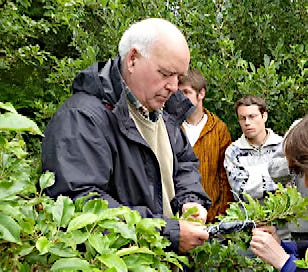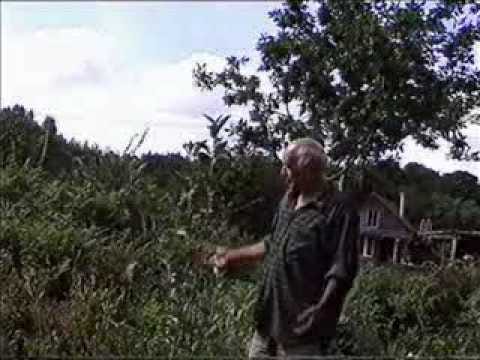In homage to Phil Corbett and the coppice orchard
a Permaculture pioneer and all round great guy
There is this guy … no, I’m going to start this a different way.
When, back in the early ‘90’s, I got into Permaculture I read a book by Mark Moody called ‘The Harmonious Wheatsmith’. Most Permaculture people at that time got a copy and learnt about this French bloke called Marc Bonfils. We read about how he had spent years trying to adapt Fukuoka’s rice/winter grain method to the climate in Northern France. It was fascinating and inspiring.
When in 1999 I moved to France I was quite surprised to discover, one … Permaculture wasn’t very widely known and two …. you could count the number of French people who had heard of Marc Bonfils on the fingers of a clumsy carpenter. It seemed equally strange that French people were learning about this pioneering French bloke from English people. Then I came across this French expression:
Nul n'est prophète en son pays
This translates as ‘no man is a prophet in his own country’ and means that it’s more difficult to be appreciated at home than abroad; one's talents are never sufficiently recognized by one's people; one is usually less successful at home than elsewhere.
Case closed.
I met Phil Corbett in 1990 during a Permaculture design course organised by Chris Dixon of E.S.P Adapt Substack fame. Steven W. Jones of Chimanimani Substack fame and Chris wrote this article recently.
Getting back to the story, Andy Langford taught the course and there was the usual motley crew of course participants. Phil Corbett was one of them, shining like a dropped iPhone in a compost toilet. I’m using colourful hyperbole for comic effect, which I’m sure you realise. Some people don’t, and I’ll get comments about how I shouldn’t promote iPhones, which I don’t. The case in point is that we’ve only once had to search for a smartphone in a long-drop compost toilet, and it was an iPhone. Can I carry on now?
‘What’s a long drop compost toilet?’
I’m never going to finish the story at this rate. It’s like a tower with the actual toilet perched up maybe 1.5 metres, and the whassnames drop into the bottom of the tower and build up and ferment nicely. There are better places to drop your smartphone. They’re not very adapted to people who get vertigo either.
So, to cut a short story long, I got friendly with Phil and was struck dumb by how much he knew about the shrubbery.
‘What do I mean by ‘shrubbery?’
If I have to explain my comic asides each time this is going to get to be a very long article so this is the last time OK? I’m using ‘shrubbery’ as an understatement (or litotes to be flash) for plants, shrubs and trees. Nature stuff.
Phil had been a market gardener for 30 odd years, he had come along to the Permaculture course to see what all the fuss was about.
In 1992 I trundled back to TIR PENRHOS ISAF, Chris and Lyn Dixon’s place, to present my stuff to try and get the Diploma in Applied Permaculture. Phil presented his work on a novel form of small (ish) scale agroforestry that he’d chosen to call ‘the coppice orchard’. From now on, I’m going to refer to it as the Corbett System.
Like I said, we got friendly, and when I got my Diploma, I started teaching Design courses myself, and I took to inviting Phil along from time to time. I carried on doing so when I moved to Brittany, France. When Phil wasn’t there, I presented the Corbett system myself, and having taught a lot of courses, a lot of French people know about it. More so than in England, which is why I told the story about Marc Bonfils at the beginning.
Yes, I love the system, I set my first one up in Brittany, it’s still there and I can confirm that it is perfectly fine to coppice apple and pear trees because I’ve done it. I am, of course, getting ahead of myself, and you may be wondering what the Corbett system is? If you are, then that means you haven’t read this article. It includes notes direct from Phil about how to set the system up and how to manage it.
The coppice orchard system
I met Phil Corbett during a Permaculture design course in 1990. He went on to develop the following system design. Phil understood the importance of agro-forestry systems and sought to adapt the Forest garden model to a system better adapted to commercial vegetable growing.
Thanks for taking the time to read it.
The major problems with the Corbett system
It doesn’t have anything to do with the system itself, it has to do with the people who manage it. The problem is getting people to coppice a line of fruit trees that are in full production! The resistance can be intense. I’ll explain that the trees will live much longer, but that doesn’t help. I tell them that the trees will fruit again, but this doesn’t help either. I finally developed the nighttime felling method: first, you arrange for a psychiatrist to visit, then you creep out the night before and cut the trees down, and leave before daylight. I’ve found that if you wait 2.7 months before visiting again, things tend to have calmed down a bit.
The second problem was down to me. Phil mentioned that the system is great for honey bees so I stuck some hives in my first one. Chased twice from tending the vegetables by irritated bees meant I started to question my decision. When it happened again, this time to a Buddhist friend who lost years of good kharma from swearing as we pulled the stings out, I moved the beehives off-site.
Why do I teach about this system?
Firstly, it’s great and well adapted to market gardeners who need to be able to harvest effectively.
Secondly, it helps maintain soil fertility.
Thirdly, the trees provide dappled shade, which means the understorey plants don’t wilt from too much sunlight.
Fourthly, because you get vegetables, fruits, and nuts from the same place.
Fifthly, the whole process that Phill went through as he developed the system is a great example of Permaculture designing.
He came up with the question. Why do we graft all of our fruit trees? Please bear in mind that Phil knew all the standard answers and some little-known ones. As I said earlier, he knew shed loads about the shrubbery. Phil also knew that there are other ways to control the vigour of a fruit tree.
Phil then went into the analysis phase of Permaculture design, and he had a stroke of luck because someone else had already asked a similar question. Hugh Ermin at Brogdale had wondered if there were other consequences to grafting other than changing the size of the mature tree. It’s a bit intrusive; after all, neither the root-stock nor the scion got the chance to swipe right on Tinder.
They come out of their winter dormancy to find themselves glued to someone they had never met before. Personally, I would probably object. Hugh found there were other consequences, but that’s another story. He had grown an example of several types of apple trees on the different rootstocks we commonly use, as it was a scientific study he needed control trees to compare the grafted trees against. To do this, he aerial layered to get an example of each variety on it’s own roots. You read the rest of this in the other article and the advantages he found with the ungrafted trees.
Phil took this information and stuck it into his Permaculture designer’s brain. Apple trees and pears are deciduous trees, and we know that a lot of these can be coppiced. The same should be true of apples and pears.
Phil also knew that when agriculture arrived in Europe, the latter was covered with dense forests. Early farmers cut clearings to open up fields to cultivate; basically, early European farming was agroforestry. Phil also knew about all the advantages of agroforestry systems and was a big fan of forest gardens and Robert Hart. That said, Phil was also a market gardener and needed to be able to harvest quickly and effectively. This is easiest done when crops are in a row. So he designed the Corbett system, rows of trees with understorey linear, north-south growing beds. All the details are in the above article.
In today’s world, we know we need to plant trees. Too often, there is a conflict between farmers and those who want to ‘save the climate’ by tree planting. It’s silly because we can do both in the same field. We can have broadscale agroforestry alley cropping, we can have market gardening using the Corbett system and we can have community orchards as forest gardens.
I would like to live to see a world like that, unfortunately, Phil won’t, as he has passed away. Let’s take this opportunity to make his system more widely known. Let’s transform all our market gardens into Corbett systems. Vegetables, fruits, nuts, firewood, BRF, what more could we ask for? They are great for wildlife; the trees attract birds who leave their droppings, which help fertilise the growing beds. They are full of insects, so the plant’s pest predators are on-site. Bees love them, as do I.
Phil did some serious design work when he came up with his system. It can be tweaked a little to adapt to local soil, microclimatic, and other conditions, but the heart of the system is seriously solid. He left us a great gift and I, for one, intend to preserve and promote this heritage.







Thanks Steve - great to read Phil's story in more detail, he was a true pioneer. I had developed my own theories about apple coppice without knowing he'd done it too, until we had a conversation back in 2014 when he mentioned about Bramley on its own roots maybe being as vigorous as you can get. Since planting my own experimental system here at Applewood in 2018, I've watched the Bramley both on M25 and on own roots far outgrow the M25 by itself, and finally made the first coppice of 20-25% of the seedlings last month, so we shall see how they do.
Thanks for reminding me of Phil, I had completely forgotten about him. I'm pretty certain I met him one time in Newcastle in connection with Ed Tyler and Scotswood Garden and certainly read plenty about his coppice orchard plans and schemes. Time to bring his ideas back to the surface especially as I've just planted a new row of random leftover fruit trees in our market garden next to the bees